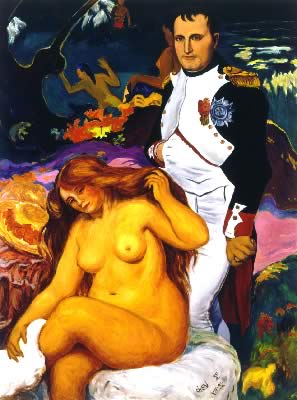 Noa Noa Napoleon Noa Noa Napoleon
#92045 48” X 36” oc
- David: “Napoleon in His Study”
- Renoir: “Bather Seated on Rock”
- Gauguin: “Fatana te Miti (By the Sea)” (1892)
This painting may cause serious investigations on Napoleon’s life to see whether he had any secret “liaison” with any woman, for example, this sensual and erotic “Bather”. Maybe Napoleon ever thought of escaping from Elba to live in an island for far far away in the Pacific, spending the rest of his life with natives and nature.Those who are familiar with art history will easily point out Renoir’s “Bather Seated on Rock” and Gauguin’s “By the Sea” and David’s portrait of Napoleon are integrated in this post-modern speculation by T. F. Chen which may mislead some historians eager for new discoveries.
“I look at nude, there are myriads of tiny tints, I, I must find the ones that will make the flesh on my canvas live and quiver”, Renoir said. With myriads of tiny soft-brushstrokes saturated in various colors, Renoir was able to produce many tender, lyrical, and sumptuous nudes and Bathers. Their ivory like skin and gracious contour are delicately modulated to become a manifestation of juicy “joie de vivre”.
To protect such “Angels on Earth”, Napoleon stands there as a guardian. The Blonde seems secure, goes on her summer toilet “en plein air” while on the beach nearby, some Tahitians are swimming or fishing.
Gauguin made Tahiti famous by his poetic presentation of an utopian society where men and women co-exist with nature and spirits. He called such kind of harmonious presentation “music”. That means not to imitate the nature, but “to faithfully obey one’s inner necessities, to sacrifice nothing to external necessities; not to be a slave of nature, but to conquer her, to use her only as a pretext for the creation of the feeling or thought that enchants” (Charles Morice, 1893, “Morcure de France”). Therefore Gauguin’s Tahiti is an idealized one, a dreamt one, a forged one, and must be different from the real, unequal, and somewhat oppressed colony of France.
As Gauguin’s Tahiti is his aesthetic masterpiece, so will be Chen’s Neo-Iconographic speculative manifestation. Don’t look for historical secret of Napoleon here, and please just enjoy such a post-modern scandal.
– T. F. Chen
|
|



